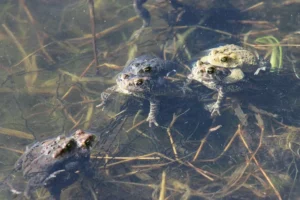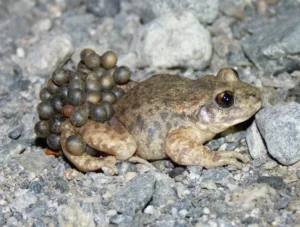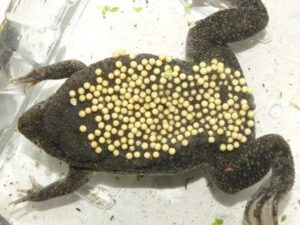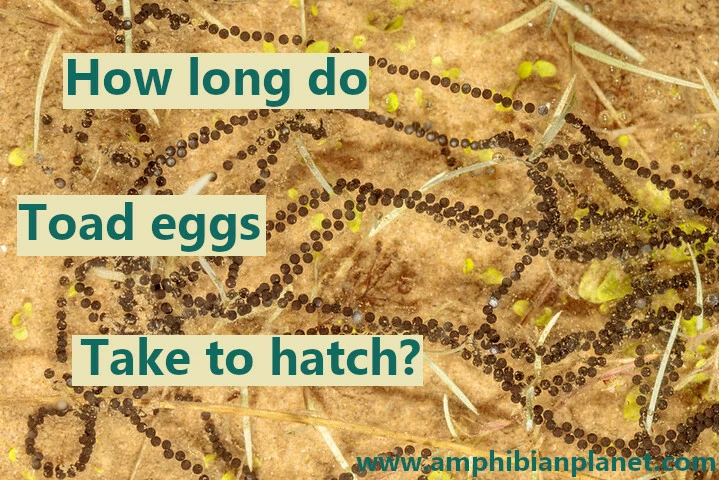Most toads reproduce by laying eggs. These eggs are typically laid in the water, usually in long strings, and attached to twigs, grass, or other vegetation just slightly below the surface of the water. But how long do toad eggs take to hatch?
The eggs laid by most toad species will hatch in anywhere from 1 to 30 days depending on the species, water temperature, and other environmental conditions. However, the eggs of some species such as the midwife toads can take up to 6 weeks to hatch.
In general, frogs and other amphibian eggs will develop and hatch faster in warmer temperatures and slower in colder temperatures.
Other factors that can affect embryonic development rates include the water depth and water pH level.
How Long the Eggs of 36 Toad Species Take to Hatch
There are over 300 toad species around the world. They live in a very wide range of habitats, from humid forests to mountainous areas, to dry regions.
With this wide distribution, different species have adapted to their environments and developed breeding methods that are practical for the areas they live in.
How long the eggs of a particular frog take to hatch can vary, sometimes very widely, between species.
For instance, the eggs of the western spadefoot toad can hatch in only 1 day, while those of the common midwife toad can take up to 2 months before they hatch.
Below is a table that shows approximately how long the eggs of 36 toad species take to hatch:
Toad Species |
Scientific Name |
How Long Their Eggs Take to Hatch (Days) |
| American toad | Anaxyrus americanus | 3 – 12 |
| Fowler’s toad | Anaxyrus fowleri | 2 – 7 |
| Western toad | Anaxyrus boreas | 3 – 12 |
| Cane toad | Rhinella marina | 2 – 3 |
| Great Plains toad | Anaxyrus cognatus | 2 – 7 |
| Canadian toad | Anaxyrus hemiophrys | 2 – 7 |
| European toad | Bufo bufo | 10 – 30 |
| Arizona toad | Anaxyrus microscaphus | 3 – 6 |
| Southern toad | Anaxyrus terrestris | 2 – 4 |
| Colorado River toad | Incilius alvarius | 2 – 12 |
| African common toad | Sclerophrys regularis | 2 – 4 |
| Mexican burrowing toad | Rhinophrynus dorsalis | 3 – 7 |
| Oriental fire-bellied toad | Bombina orientalis | 3 – 6 |
| Wyoming toad | Anaxyrus baxteri | 3 – 20 |
| Eastern spadefoot toad | Scaphiopus holbrookii | 1 – 15 |
| Western spadefoot toad | Spea hammondii | 1 – 6 |
| North American green toad | Anaxyrus debilis | 1 – 2 |
| Black toad | Anaxyrus exsul | 3 – 5 |
| Houston toad | Anaxyrus houstonensis | 3 – 7 |
| Texas toad | Anaxyrus specious | 2 – 3 |
| Red-spotted toad | Anaxyrus punctatus | 2 – 3 |
| Yosemite toad | Anaxyrus canorus | 10 – 12 |
| Woodhouse’s toad | Anaxyrus woodhousii | 2 – 4 |
| Oak toad | Anaxyrus quercicus | 1 – 3 |
| Arroyo toad | Anaxyrus californicus | 4 – 6 |
| Sonoran green toad | Anaxyrus retiformis | 2 – 12 |
| Amargosa toad | Anaxyrus nelsoni | 3 – 12 |
| European green toad | Bufotes viridis | 3 – 7 |
| Common midwife toad | Alytes obstetricans | 21 – 45 |
| Asian common toad | Duttaphrynus melanostictus | 1 – 2 |
| Asiatic toad | Bufo gargarizans | 10 – 30 |
| Taiwan Common Toad | Bufo bankorensis | 3 – 7 |
| Iberian spadefoot toad | Pelobates cultripes | 10 – 16 |
| European common spadefoot toad | Pelobates fuscus | 5 – 11 |
| Syrian spadefoot toad | Pelobates syriacus | 2 – 3 |
| Moroccan spadefoot toad | Pelobates varaldii | 3 – 7 |
Temperature Affects How Long Hatching Takes
Many toad species have extended breeding seasons, and their eggs are exposed to a wide range of temperatures depending on the time of year when they are laid.
Toad eggs laid when the weather is colder, usually take longer to hatch than those laid when the weather is warmer. This is because temperature affects embryonic development rates.
In general, most amphibian eggs will develop and hatch faster in warmer temperatures and slower in colder temperatures.

For this reason, many toads prefer to lay their eggs in open areas that get a lot of sunlight, as the water will be warmed by the sun, helping the embryos develop faster. Cold, shaded ponds with little sunlight will be avoided by most toads.
In addition, frog and toad eggs often have higher concentrations of melanin in their dorsal hemisphere which serves as protection from ultraviolet radiation, preventing it from penetrating into deeper layers of the egg.
It may also serve as a means of absorbing and retaining heat.
Other Factors That Affect Embryonic Development Rates
Apart from temperature, there are a few other factors that can influence how long the eggs of a particular toad take to hatch.
1. Species
As earlier mentioned, there are over 300 toad species around the world. The embryos of some toad species are genetically programmed to develop faster than others, provided that the environmental conditions are supportive.
For example, the eggs of toads which lay eggs in temporal pools that dry up in the summer, will hatch faster. This allows the tadpoles to develop and escape their ponds before the water dries out.

However, the embryos of midwife toads can afford to develop at much slower rates, as they are carried around on land by their parents. They are in no rush to hatch.
2. Water Depth
Eggs laid in shallow water typically hatch faster than those laid in deeper water. This is because shallow water tends warmer than deeper water.
Shallow receives more solar radiation and heat from the atmosphere, so it warms up faster than deeper water.
Shallower, smaller ponds also change temperature more quickly than larger, deeper ponds simply because less water has to be heated, or cooled.
Even in deeper water bodies, the top of the water is usually warmer than the bottom layers – and since warm water is less dense than colder water, it stays on top.
3. Water pH Level
Amphibian eggs are sensitive to acidity.
If the water is too acidic or basic, it can kill the embryos by preventing expansion of perivitelline membranes and inhibiting hatching enzymes.
It can also delay hatching and disrupt embryonic development
Some Toad Tadpoles Can Hatch Earlier Than Is Typical
The embryos of some toad species, such as those of the American toad, can hatch themselves early in response to environmental threats. This is known as “environmentally cued hatching“.
In one experiment, researchers tested the ability of American toads to alter their hatching timing in response to environmental risk.
They found that; when infected with water mold, American toad eggs hatched 44% earlier than non-infected eggs.
The eggs also hatch significantly earlier than normal when exposed to simulated cues of predator presence.
This adaptation is a strategy to improve the embryos’ chances of survival because American toads often lay eggs in ponds – where pathogens and predators accumulate throughout the breeding season.
Hatching early means the tadpoles have a chance to escape.
Surinam Toads Have a Unique Breeding Strategy
Surinam Toads are a fully aquatic toad species from the northern Amazon basin of South America. These toads are unique, in that the female gives “birth” to the young out of her back!
The female releases about 100 eggs during mating. Next, the male fertilizes the eggs and pushes them into the female’s back – and the skin of the female then encloses the eggs.

The embryos will develop to the tadpole stage inside of their egg pockets but will remain until they complete their development and become toadlets in about three to four months.
Once the eggs hatch, fully formed toads will pop out of the female’s back.
Some Toads Do Not Lay Eggs
While most toad species lay eggs, there are a few exceptions. For example, Frontier forest toads (Nectophrynoides frontierei), found in the Eastern Arc Mountains of Tanzania do not lay eggs.
Instead, they retain the eggs inside their bodies until they hatch, and then give birth to young fully-developed toads. This is known as “Ovoviviparity.”
Frontier forest toads live in areas with steep terrain, and low availability of accumulated water sources. Giving birth to live young, allows them to reproduce in these harsh environments.
Frequently Asked Questions:
Do toad eggs turn into tadpoles?
The eggs laid by most toad species hatch into tadpoles, which will go through the process of metamorphosis, and transform into young toads over time. Once transformed, these young toads will live entirely on land, and will only return to the water when sexually mature, to breed.
How long does it take for toad eggs to turn into tadpoles?
In general, the eggs of most toad species take anywhere from one, to thirty days to turn into tadpoles, depending on the species, water temperature, and other environmental conditions. However, the eggs of some species, such as the midwife toads can take up to 6 weeks to turn into tadpoles.
Photo credit: Back from the Brink (CC BY-NC 2.0).


